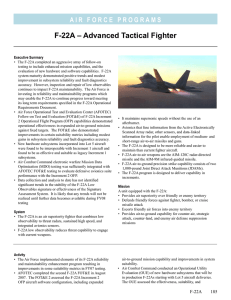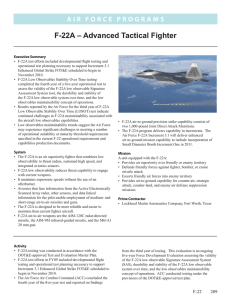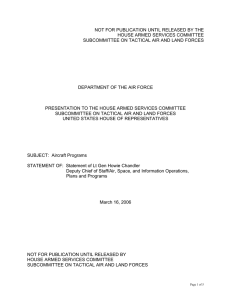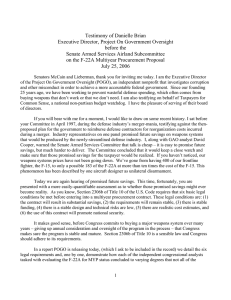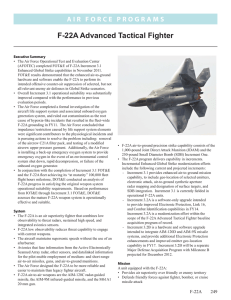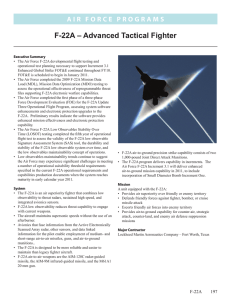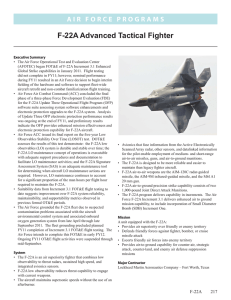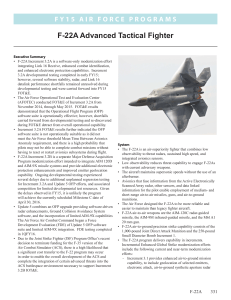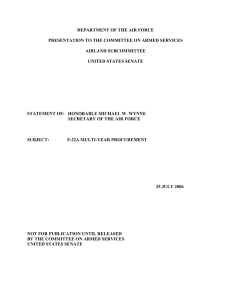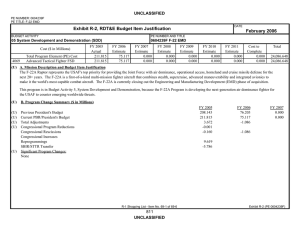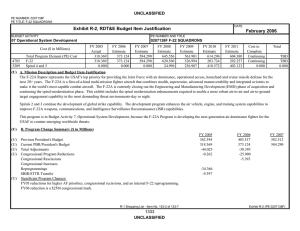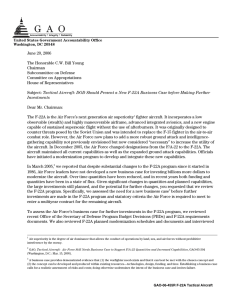F-22A – Advanced Tactical Fighter
advertisement
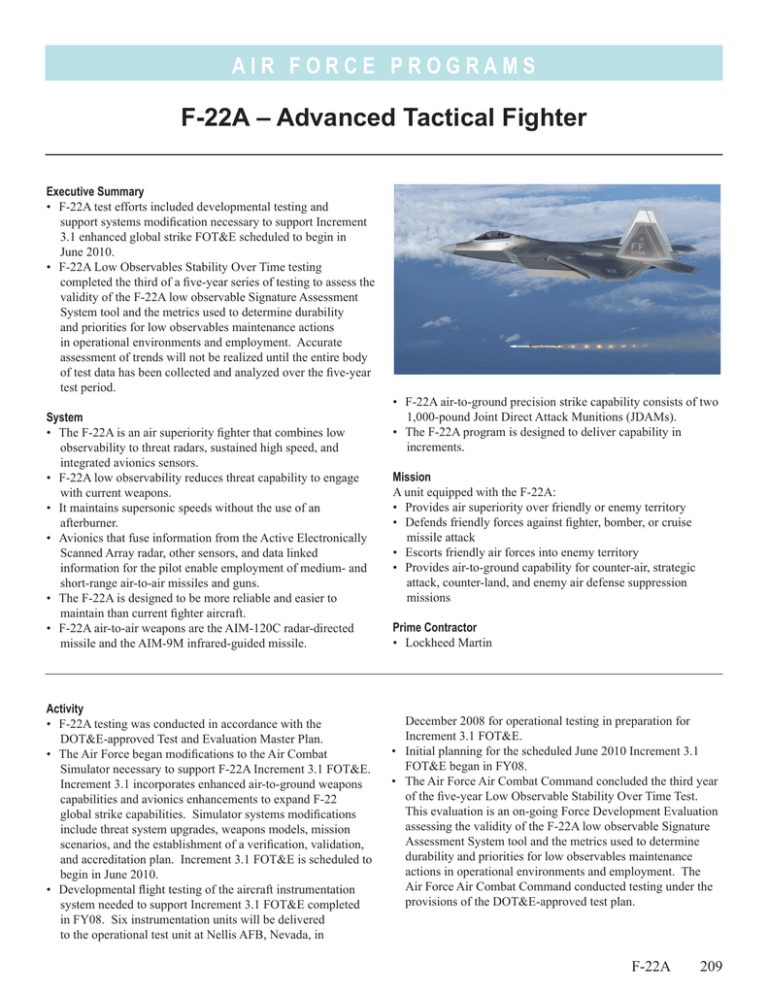
A i r F o r c e P RO G R A M S F-22A – Advanced Tactical Fighter Executive Summary • F-22A test efforts included developmental testing and support systems modification necessary to support Increment 3.1 enhanced global strike FOT&E scheduled to begin in June 2010. • F-22A Low Observables Stability Over Time testing completed the third of a five-year series of testing to assess the validity of the F-22A low observable Signature Assessment System tool and the metrics used to determine durability and priorities for low observables maintenance actions in operational environments and employment. Accurate assessment of trends will not be realized until the entire body of test data has been collected and analyzed over the five-year test period. System • The F-22A is an air superiority fighter that combines low observability to threat radars, sustained high speed, and integrated avionics sensors. • F-22A low observability reduces threat capability to engage with current weapons. • It maintains supersonic speeds without the use of an afterburner. • Avionics that fuse information from the Active Electronically Scanned Array radar, other sensors, and data linked information for the pilot enable employment of medium- and short-range air-to-air missiles and guns. • The F-22A is designed to be more reliable and easier to maintain than current fighter aircraft. • F-22A air-to-air weapons are the AIM-120C radar-directed missile and the AIM-9M infrared-guided missile. Activity • F-22A testing was conducted in accordance with the DOT&E‑approved Test and Evaluation Master Plan. • The Air Force began modifications to the Air Combat Simulator necessary to support F-22A Increment 3.1 FOT&E. Increment 3.1 incorporates enhanced air-to-ground weapons capabilities and avionics enhancements to expand F-22 global strike capabilities. Simulator systems modifications include threat system upgrades, weapons models, mission scenarios, and the establishment of a verification, validation, and accreditation plan. Increment 3.1 FOT&E is scheduled to begin in June 2010. • Developmental flight testing of the aircraft instrumentation system needed to support Increment 3.1 FOT&E completed in FY08. Six instrumentation units will be delivered to the operational test unit at Nellis AFB, Nevada, in • F-22A air-to-ground precision strike capability consists of two 1,000-pound Joint Direct Attack Munitions (JDAMs). • The F-22A program is designed to deliver capability in increments. Mission A unit equipped with the F-22A: • Provides air superiority over friendly or enemy territory • Defends friendly forces against fighter, bomber, or cruise missile attack • Escorts friendly air forces into enemy territory • Provides air-to-ground capability for counter-air, strategic attack, counter-land, and enemy air defense suppression missions Prime Contractor • Lockheed Martin December 2008 for operational testing in preparation for Increment 3.1 FOT&E. • Initial planning for the scheduled June 2010 Increment 3.1 FOT&E began in FY08. • The Air Force Air Combat Command concluded the third year of the five-year Low Observable Stability Over Time Test. This evaluation is an on-going Force Development Evaluation assessing the validity of the F-22A low observable Signature Assessment System tool and the metrics used to determine durability and priorities for low observables maintenance actions in operational environments and employment. The Air Force Air Combat Command conducted testing under the provisions of the DOT&E-approved test plan. F-22A 209 A i r F o r c e P RO G R A M S • Air Combat Command continued electronic warfare software development and testing throughout FY08 under the DOT&E‑approved Mission Data Optimization Test Plan. Assessment • F-22A FY08 test efforts largely supported future Increment 3.1 FOT&E scheduled for June 2010. Developmental testing and operational test planning efforts suggest the program is progressing to meet the Increment 3.1 FOT&E target date. • F-22A Low Observables Stability Over Time test data collection and analysis to date has not revealed significant trends in the stability of the F-22A low observables signature 210 F-22A or effectiveness of the Signature Assessment System. Continued collection and analysis of data, in accordance with the DOT&E-approved test plan is ongoing and accurate assessment of trends will not be realized until the entire body of test data has been collected and analyzed over the five-year test period. Recommendations • Status of Previous Recommendations. The Air Force continues to address all previous recommendations. • FY08 Recommendations. None.
